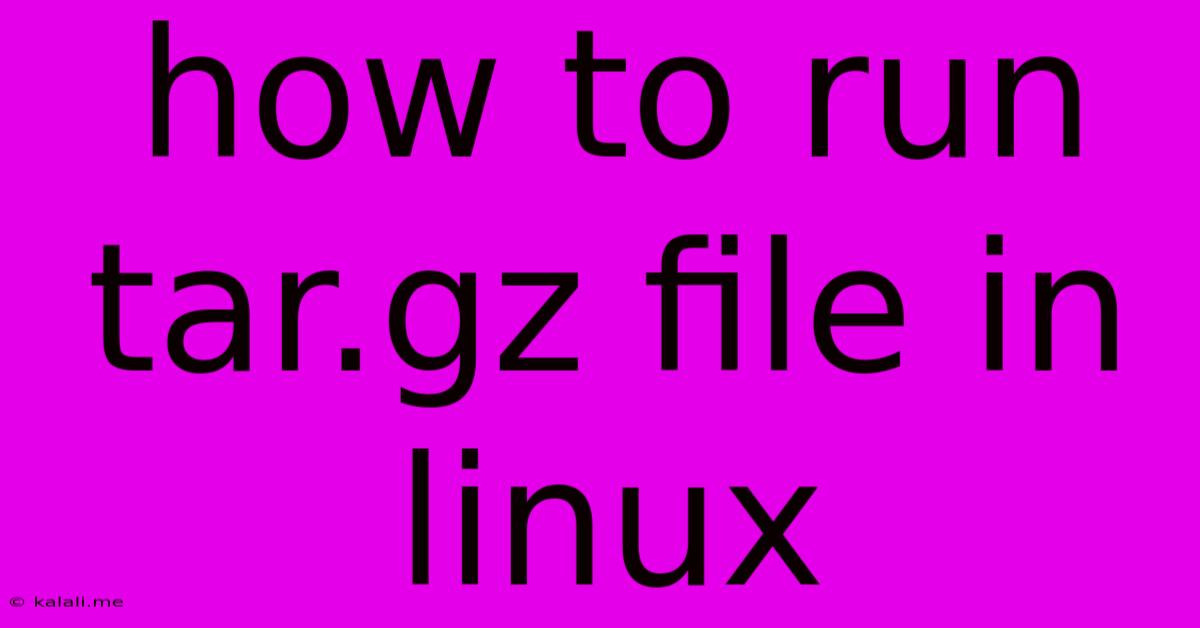How To Run Tar.gz File In Linux
Kalali
May 30, 2025 · 3 min read

Table of Contents
How to Run a .tar.gz File in Linux: A Comprehensive Guide
This guide will walk you through the process of extracting and running files contained within a .tar.gz archive in Linux. Understanding how to manage these compressed archives is a fundamental skill for any Linux user. This article will cover the extraction process, handling executable files, and troubleshooting common issues.
What is a .tar.gz file?
A .tar.gz file (also known as a .tgz file) is a compressed archive. The tar command creates the archive, bundling multiple files and directories into a single file. The gzip command then compresses this archive, reducing its size for easier storage and transfer. To "run" a .tar.gz file, you first need to extract its contents. It doesn't "run" in the same way an executable file does; instead, you run the programs inside the archive after extraction.
Extracting a .tar.gz file:
The primary tool for extracting .tar.gz files is the tar command. This command is typically pre-installed on most Linux distributions. Here's how to use it:
tar -xzvf filename.tar.gz
Let's break down the command:
tar: This invokes the tar command.-x: This option specifies extraction.-z: This option indicates that the archive is compressed with gzip.-v: This is an optional verbose option; it displays the files being extracted.-f: This option specifies the archive filename.filename.tar.gz: Replace this with the actual name of your.tar.gzfile.
This command will extract the contents of filename.tar.gz into the current directory. If you want to extract the contents to a specific directory, use the -C option:
tar -xzvf filename.tar.gz -C /path/to/destination/directory
Replace /path/to/destination/directory with your desired location.
Running Executable Files from a .tar.gz Archive:
After extraction, you'll find the files and directories originally contained within the archive. If the archive contains executable files (usually identified by the x permission bit), you can run them using the standard Linux method:
./path/to/executable/file
Remember to replace ./path/to/executable/file with the actual path to the executable within the extracted directory. You may need to make the file executable first using the chmod command:
chmod +x path/to/executable/file
This grants execute permission for the owner.
Troubleshooting:
- Permission Errors: If you encounter permission errors, ensure you have the necessary permissions to access and execute the files. Use the
sudocommand if needed to gain root privileges. - Incorrect File Path: Double-check the file path to ensure you're pointing to the correct executable.
- Missing Dependencies: Some programs may require additional libraries or dependencies. If the program doesn't run, you might need to install these dependencies using your distribution's package manager (like
apton Debian/Ubuntu oryumon Fedora/CentOS). - Corrupted Archive: If the extraction fails, the archive might be corrupted. Try downloading it again from a reliable source.
Conclusion:
Extracting and running files from a .tar.gz archive is a common task in Linux. By understanding the tar command and its options, you can efficiently manage these compressed archives and execute the programs they contain. Remember to always exercise caution when running files from untrusted sources. Always check the contents of the archive before extraction and running any executables.
Latest Posts
Latest Posts
-
What Did Jesus Say About The Old Testament Law
May 31, 2025
-
Does Gnu Cash Import From Banks
May 31, 2025
-
Why For Desicion Tree Entropy We Use Log Based 2
May 31, 2025
-
How To Make A Capsule In Blender
May 31, 2025
-
What Does Df Mean In Text
May 31, 2025
Related Post
Thank you for visiting our website which covers about How To Run Tar.gz File In Linux . We hope the information provided has been useful to you. Feel free to contact us if you have any questions or need further assistance. See you next time and don't miss to bookmark.